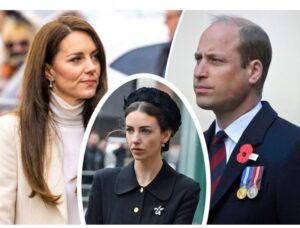CELEBRITY
Reports speculating that Prince William had an affair with British noblewoman Sarah Rose Hanbury have been quietly deleted by UK media outlets, a Vulture investigation suggests that…

The British royal family has dominated headlines in 2024, the biggest story, of course, being weeks of conspiracy-theory-laden social-media rumors about the absence of Kate Middleton or Catherine, the Princess of Wales from public life amid a health crisis. If you were paying attention to the twists and turns of this multi-month saga, you may have encountered the name Rose Hanbury or, as she is properly known, the Marchioness of Cholmondeley (pronounced CHUM-lee). Since 2019, rumors have circulated on gossip blogs and royal social-media spaces of a supposed affair between the marchioness and Prince William despite lawyers for both parties strongly denying that there’s any truth to them. The controversy over Catherine’s whereabouts earlier this year exported the speculations across the pond and into mainstream news after Stephen Colbert joked about the alleged affair between William and Rose, whom Colbert referred to as “the Marching Band of Chicanery” and “the Marcus Mumford of Chumbawamba” during a March 12 Late Show monologue. The joke led to Rose breaking her five-year silence with her first public statement ever denying the rumors, issued though her lawyers, as well as a legal warning sent to CBS about Colbert’s “royal mistress” remarks.

As far as royal scandals go, the Rose-William story barely registers on a list that includes the far more sordid (and substantiated) stories of the previous generation of Windsors, such as Squidgygate, the now-King Charles’s infamous tampon comments, and the whole Fergie toe-sucking thing. But if you start to dig a little more into the history of these recent royal-affair rumors — if you go looking for information about the Marchioness of Cholmondeley’s connections to the House of Windsor — you quickly encounter a problem. Years of U.K. media coverage about Rose have now vanished. And, to be clear, we’re not talking about just allegations of “aristocratic extramarital romance” but also allusions to an apparent tension betweenfriends Rose and Catherine. Foundational stories about Rose and the future king and queen now lead to unavailable pages or redirect to the host website’s homepage. Other stories remain online but were updated post-publication to remove details about the “feud” or other unspecified “rumors” about Rose, William, and Catherine, as seen via the Internet Archive’s Wayback Machine or archive.today. Vulture is unable to share links to the deleted stories for legal reasons. However, the mysterious individuals in charge of removing stories didn’t do a great job cleaning up after themselves. Broken links to these vanished stories still exist in each publication’s royal coverage from this timeframe and, in many cases, on these outlets’ official social-media accounts.

In total, this investigation found 21 deleted stories and six stories that were edited post-publication to remove information, published from 2019 to 2024. All of the media outlets in question are based in the U.K.: Tatler, the Daily Mail/MailOnline/Mail on Sunday, the Evening Standard, the Mirror, the Sun, the Daily Express, the Guardian. Vulture sent several requests for comments to these outlets over a period of three months; the Guardian was the only news company to respond.
So where did they go? The gossipmongers’ assumption has always been that the Palace is pulling strings behind the scenes, leaning on media outlets to suppress news of or speculation about the alleged affair in order to protect the future king. (There have even been — wholly unsubstantiated, for the record — rumors on social media about a “media blackout” or “super injunction” on stories about William and Rose.) According to a Daily Beast story from April 2019, royal lawyers sent strongly worded letters to at least one media outlet warning them off reporting on the affair rumors, not just because they were “false and highly damaging,” but because they apparently violated Article 8 of the European Convention to Human Rights, they claimed. But there have been no reports of the Palace asking media organizations to remove stories or parts of stories, and certainly no statements from the U.K. media outlets in question — or notices to readers — explaining why they’ve chosen to delete paragraphs and even entire posts. Legal representatives for both the royal family and the Marchioness of Cholmondeley strongly denied all rumors of an alleged affair between William and Rose but declined to provide any specific on-the-record statements about the deletion of or removal of information from the stories referenced above.

And so, amid the rumors, Rose’s public profile has continued to rise. Her friendship with Catherine has been the subject of many glowing stories over the past two years, and, more and more, Rose has been the standalone subject of U.K. media articles. Her presence at events, her clothing, the fact that she sent a “fan” a thank-you note in response to a birthday card has all, for some reason, been deemed newsworthy. Then there are the endless Who Is Rose Hanbury? articles.
To answer questions about the Marchioness of Cholmondeley’s current press coverage and the many stories that have disappeared, you need to start from the beginning: her days as an “eye-wateringly sexy” model and an “absolute heartbreaker” of an ingénue socialite. Here’s how the media has covered Rose over the years — in many ways, that’s more interesting and illuminating than the rumors themselves.






